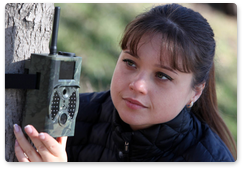Some 100 new camera traps for monitoring the numbers of Far Eastern leopards and Amur tigers are being installed in the southern and northern zones at the Leopard Land National Park. This was made possible due to the joint activity of the national park, WWF-Russia, the Institute for Sustainable Development as well as the Wildlife Conservation Society (WCS) Russia.
About 190 camera traps operated in Leopard Land Park last winter. Most of them were installed on uplands – the leopard’s main habitats.
This year, the bulk of cameras will be installed not in the mountains, but in the valley, in order to keep track of both leopards and tigers.
“The information on the leopard population was more important, and fewer camera traps for the tiger were installed. As a result, according to the camera monitoring data, only seven tigers have been registered in Leopard Land Park. However, a count based on tracks in the snow revealed that about 20 tigers inhabit this land,” Yelena Salmanova, Deputy Director for Science and Environmental Education of Leopard Land Park, said. “It is important to check this information using new camera traps.”
The data on the tiger population in Leopard Land National Park will enable researchers to see how strong the competition between the two Red Book cats is. This also depends on the population of hoofed animals, which are the major source of food for the predators. The shots taken by camera traps can provide this information as well.
At present, employees of Leopard Land Park, jointly with experts of the Institute for Sustainable Development, are installing cameras in the south of the national park. In the spring of 2014, the park’s southern zone will be equipped with 42 new camera traps, which will work for four months without recharging.
Experts of the national park, jointly with the WCS, are installing another 60 camera traps in the north of Leopard Land National Park. Director of WCS Russia Dale Miquelle said that in 2014, they have purchased more modern camera traps than in the past. Their memory and battery size allow them to take more photos and operate for longer. This will enable experts to form a relatively comprehensive picture of the population of both the Far Eastern leopard and the Amur tiger in the national park.
“The work of employees of the national park, WWF and WCS is a perfect example of cooperation when joining efforts leads to excellent results,” Dale Miquelle said. “We hope to continue our common work as we can only preserve the unique cats of the Primorye Territory together.”
In 2014, in addition to camera monitoring in the southern and northern zones of Leopard Land National Park, similar survey will be carried out in the Poltavsky Reserve for the first time.
For many years, the Krounovka River has been the northern border of the leopard’s range. Four years ago, a single male leopard started to leave footprints on the territory of the Poltavsky Reserve, and a female leopard with a cub was found there last winter. It is important to know what is happening with these animals and how they have adapted to the territory’s environment.









 ABOUT THE PROGRAMME
ABOUT THE PROGRAMME
 FAR EASTERN LEOPARD RESEARCH: A HISTORY
FAR EASTERN LEOPARD RESEARCH: A HISTORY
 FAR EASTERN LEOPARD: LIFE, BEHAVIOUR AND MORE
FAR EASTERN LEOPARD: LIFE, BEHAVIOUR AND MORE
 SERGEY IVANOV'S VISIT
SERGEY IVANOV'S VISIT
 NEWS
NEWS
 MULTIMEDIA
MULTIMEDIA